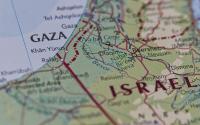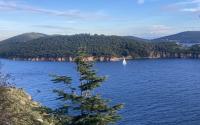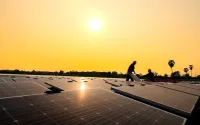There was a meeting on the weekend of December 9-10 in Cochabamba in Bolivia of major South American leaders. It was a very important meeting. One index of its importance is that it was unreported, virtually unreported apart from the wire services. So every editor knew about it. Since I suspect you didn't read that wire service report, I’ll read a few things from it to indicate why it was so important.The South American leaders agreed to create a high-level commission to study the idea of forming a continent-wide community similar to the European Union. This is the presidents and envoys of major nations, and there was the two-day summit of what's called the South American Community of Nations, hosted by Evo Morales in Cochabamba, the president of Bolivia. The leaders agreed to form a study group to look at the possibility of creating a continent-wide union and even a South American parliament. The result, according to the AP report, left fiery Venezuelan President Hugo Chavez, long an agitator for the region, taking a greater role on the world stage, pleased, but impatient. It goes on to say that the discussion over South American unity will continue later this month, when MERCOSUR, the South American trading bloc, has its regular meeting that will include leaders from Brazil, Argentina, Venezuela, Paraguay and Uruguay. (L-R bottom row ) President of Venezuela Hugo Chavez, President of Brazil Luiz Inacio Lula Da Silva, President of Bolivia Evo Morales, President of Chile Michelle Bachelet, (L-R top row) Secretary for South American Affairs of Mexico Jorge Chen, Representative of Surinam Robby Ramlakhan, Vice-president of Argentina Daniel Scioli and Foreign Minister of Colombia Consuelo Araujo pose for an official photo at the South American Community of Nations summit in Cochabamba December 9, 2006.There is one -- has been one point of hostility in South America. That's Peru, Venezuela. But the article points out that Chavez and Peruvian President Alan Garcia took advantage of the summit to bury the hatchet, after having exchanged insults earlier in the year. And that is the only real conflict in South America at this time. So that seems to have been smoothed over.The new Ecuadorian President Rafael Correa proposed a land and river trade route linking the Brazilian Amazon Rainforest to Ecuador's Pacific Coast, suggesting that for South America, it could be kind of like an alternative to the Panama Canal.Chavez and Morales celebrated a new joint project, the gas separation plant in Bolivia's gas-rich region. It’s a joint venture with Petrovesa (PDVSA, Petroleos de Venezuela, SA. Pronounced “pedevesa”), the Venezuelan oil company, and the Bolivian state energy company. And it continues. Venezuela is the only Latin American member of OPEC and has by far the largest proven oil reserves outside the Middle East, by some measures maybe even comparable to Saudi Arabia. There were also contributions, constructive, interesting contributions by Lula da Silva, Brazil's president, Michelle Bachelet of Chile, and others. All of this is extremely important.This is the first time since the Spanish conquests, 500 years, that there have been real moves toward integration in South America. The countries have been very separated from one another. And integration is going to be a prerequisite for authentic independence. There have been attempts at independence, but they've been crushed, often very violently, partly because of lack of regional support. Because there was very little regional cooperation, they could be picked off one by one.That’s what has happened since the 1960s. The Kennedy administration orchestrated a coup in Brazil. It was the first of a series of falling dominoes. Neo-Nazi-style national security states spread across the hemisphere. Chile was one of them. Then there were Reagan's terrorist wars in the 1980s, which devastated Central America and the Caribbean. It was the worst plague of repression in the history of Latin America since the original conquests. But integration lays the basis for potential independence, and that's of extreme significance. Latin America’s colonial history -- Spain, Europe, the United States -- not only divided countries from one another, it also left a sharp internal division within the countries, every one, between a very wealthy small elite and a huge mass of impoverished people. The correlation to race is fairly close. Typically, the rich elite was white, European, westernized; and the poor mass of the population was indigenous, Indian, black, intermingled, and so on. It's a fairly close correlation, and it continues right to the present.The white, mostly white, elites -- who ran the countries -- were not integrated with, had very few relations with, the other countries of the region. They were Western-oriented. You can see that in all sorts of ways. That's where the capital was exported. That's where the second homes were, where the children went to university, where their cultural connections were. And they had very little responsibility in their own societies. So there’s a very sharp division.You can see the pattern in imports. Imports are overwhelmingly luxury goods. Development, such as it was, was mostly foreign. Latin America was much more open to foreign investment than, say, East Asia. It’s part of the reason for their radically different paths of development in the last couple of decades.And, of course, the elite elements were strongly sympathetic to the neoliberal programs of the last 25 years, which enriched them -- destroyed the countries, but enriched them. Latin America, more than any region in the world, outside of southern Africa, adhered rigorously to the so-called Washington Consensus, what's called outside the United States the neoliberal programs of roughly the past 25 or 30 years. And where they were rigorously applied, almost without exception, they led to disaster. Very striking correlation. Sharp reduction in rates of growth, other macroeconomic indices, all the social effects that go along with that.Actually, the comparison to East Asia is very striking. Latin America is potentially a much richer area. I mean, a century ago, it was taken for granted that Brazil would be what was called the “Colossus of the South,” comparable to the Colossus of the North. Haiti, now one of the poorest countries in the world, was the richest colony in the world, a source of much of France’s wealth, now devastated, first by France, then by the United States. And Venezuela -- enormous wealth -- was taken over by the United States around 1920, right at the beginning of the oil age, It had been a British dependency, but Woodrow Wilson kicked the British out, recognizing that control of oil was going to be important, and supported a vicious dictator. From that point, more or less, it goes on until the present. So the resources and the potential were always there. Very rich.In contrast, East Asia had almost no resources, but they followed a different developmental path. In Latin America, imports were luxury goods for the rich. In East Asia, they were capital goods for development. They had state-coordinated development programs. They disregarded the Washington Consensus almost totally. Capital controls, controls on export of capital, pretty egalitarian societies -- authoritarian, sometimes, pretty harsh -- but educational programs, health programs, and so on. In fact, they followed pretty much the developmental paths of the currently wealthy countries, which are radically different from the rules that are being imposed on the South.And that goes way back in history. You go back to the 17th century, when the commercial and industrial centers of the world were China and India. Life expectancy in Japan was greater than in Europe. Europe was kind of a barbarian outpost, but it had advantages, mainly in savagery. It conquered the world, imposed something like the neoliberal rules on the conquered regions, and for itself, adopted very high protectionism, a lot of state intervention and so on. So Europe developed.The United States, as a typical case, had the highest tariffs in the world, most protectionist country in the world during the period of its great development. In fact, as late as 1950, when the United States literally had half the world's wealth, its tariffs were higher than the Latin American countries today, which are being ordered to reduce them.Massive state intervention in the economy. Economists don't talk about it much, but the current economy in the United States relies very heavily on the state sector. That's where you get your computers and the internet and your airplane traffic and transit of goods, container ships and so on, almost entirely comes out of the state sector, including pharmaceuticals, management techniques, and so on. I won’t go on into that, but it’s a strong correlation right through history. Those are the methods of development.The neoliberal methods created the third world, and in the past 30 years, they have led to disasters in Latin America and southern Africa, the places that most rigorously adhered to them. But there was growth and development in East Asia, which disregarded them, following instead pretty much the model of the currently rich countries.Well, there’s a chance that that will begin to change. There are finally efforts inside South America -- unfortunately not in Central America, which has just been pretty much devastated by the terror of the ’80s particularly. But in South America, from Venezuela to Argentina, it’s, I think, the most exciting place in the world. After 500 years, there’s a beginning of efforts to overcome these overwhelming problems. The integration that's taking place is one example.There are efforts of the Indian population. The indigenous population is, for the first time in hundreds of years, in some countries really beginning to take a very active role in their own affairs. In Bolivia, they succeeded in taking over the country, controlling their resources. It’s also leading to significant democratization, real democracy, in which the population participates. So it takes a Bolivia -- it’s the poorest country in South America (Haiti is poorer in the hemisphere). It had a real democratic election last year, of a kind that you can't imagine in the United States, or in Europe, for that matter. There was mass popular participation, and people knew what the issues were. The issues were crystal clear and very important. And people didn't just participate on election day. These are the things they had been struggling about for years. Actually, Cochabamba is a symbol of it.This is a lightly edited and excerpted version of Noam Chomsky’s December 15, 2006 talk to a Boston meeting of Mass Global Action following a recent trip to Chile and Peru. It is posted at Japan Focus on December 20, 2006. Noam Chomsky’s most recent book is Perilous Power: The Middle East and U.S. Foreign Policy: Dialogues on Terror, Democracy, War and Justice.
(L-R bottom row ) President of Venezuela Hugo Chavez, President of Brazil Luiz Inacio Lula Da Silva, President of Bolivia Evo Morales, President of Chile Michelle Bachelet, (L-R top row) Secretary for South American Affairs of Mexico Jorge Chen, Representative of Surinam Robby Ramlakhan, Vice-president of Argentina Daniel Scioli and Foreign Minister of Colombia Consuelo Araujo pose for an official photo at the South American Community of Nations summit in Cochabamba December 9, 2006.There is one -- has been one point of hostility in South America. That's Peru, Venezuela. But the article points out that Chavez and Peruvian President Alan Garcia took advantage of the summit to bury the hatchet, after having exchanged insults earlier in the year. And that is the only real conflict in South America at this time. So that seems to have been smoothed over.The new Ecuadorian President Rafael Correa proposed a land and river trade route linking the Brazilian Amazon Rainforest to Ecuador's Pacific Coast, suggesting that for South America, it could be kind of like an alternative to the Panama Canal.Chavez and Morales celebrated a new joint project, the gas separation plant in Bolivia's gas-rich region. It’s a joint venture with Petrovesa (PDVSA, Petroleos de Venezuela, SA. Pronounced “pedevesa”), the Venezuelan oil company, and the Bolivian state energy company. And it continues. Venezuela is the only Latin American member of OPEC and has by far the largest proven oil reserves outside the Middle East, by some measures maybe even comparable to Saudi Arabia. There were also contributions, constructive, interesting contributions by Lula da Silva, Brazil's president, Michelle Bachelet of Chile, and others. All of this is extremely important.This is the first time since the Spanish conquests, 500 years, that there have been real moves toward integration in South America. The countries have been very separated from one another. And integration is going to be a prerequisite for authentic independence. There have been attempts at independence, but they've been crushed, often very violently, partly because of lack of regional support. Because there was very little regional cooperation, they could be picked off one by one.That’s what has happened since the 1960s. The Kennedy administration orchestrated a coup in Brazil. It was the first of a series of falling dominoes. Neo-Nazi-style national security states spread across the hemisphere. Chile was one of them. Then there were Reagan's terrorist wars in the 1980s, which devastated Central America and the Caribbean. It was the worst plague of repression in the history of Latin America since the original conquests. But integration lays the basis for potential independence, and that's of extreme significance. Latin America’s colonial history -- Spain, Europe, the United States -- not only divided countries from one another, it also left a sharp internal division within the countries, every one, between a very wealthy small elite and a huge mass of impoverished people. The correlation to race is fairly close. Typically, the rich elite was white, European, westernized; and the poor mass of the population was indigenous, Indian, black, intermingled, and so on. It's a fairly close correlation, and it continues right to the present.The white, mostly white, elites -- who ran the countries -- were not integrated with, had very few relations with, the other countries of the region. They were Western-oriented. You can see that in all sorts of ways. That's where the capital was exported. That's where the second homes were, where the children went to university, where their cultural connections were. And they had very little responsibility in their own societies. So there’s a very sharp division.You can see the pattern in imports. Imports are overwhelmingly luxury goods. Development, such as it was, was mostly foreign. Latin America was much more open to foreign investment than, say, East Asia. It’s part of the reason for their radically different paths of development in the last couple of decades.And, of course, the elite elements were strongly sympathetic to the neoliberal programs of the last 25 years, which enriched them -- destroyed the countries, but enriched them. Latin America, more than any region in the world, outside of southern Africa, adhered rigorously to the so-called Washington Consensus, what's called outside the United States the neoliberal programs of roughly the past 25 or 30 years. And where they were rigorously applied, almost without exception, they led to disaster. Very striking correlation. Sharp reduction in rates of growth, other macroeconomic indices, all the social effects that go along with that.Actually, the comparison to East Asia is very striking. Latin America is potentially a much richer area. I mean, a century ago, it was taken for granted that Brazil would be what was called the “Colossus of the South,” comparable to the Colossus of the North. Haiti, now one of the poorest countries in the world, was the richest colony in the world, a source of much of France’s wealth, now devastated, first by France, then by the United States. And Venezuela -- enormous wealth -- was taken over by the United States around 1920, right at the beginning of the oil age, It had been a British dependency, but Woodrow Wilson kicked the British out, recognizing that control of oil was going to be important, and supported a vicious dictator. From that point, more or less, it goes on until the present. So the resources and the potential were always there. Very rich.In contrast, East Asia had almost no resources, but they followed a different developmental path. In Latin America, imports were luxury goods for the rich. In East Asia, they were capital goods for development. They had state-coordinated development programs. They disregarded the Washington Consensus almost totally. Capital controls, controls on export of capital, pretty egalitarian societies -- authoritarian, sometimes, pretty harsh -- but educational programs, health programs, and so on. In fact, they followed pretty much the developmental paths of the currently wealthy countries, which are radically different from the rules that are being imposed on the South.And that goes way back in history. You go back to the 17th century, when the commercial and industrial centers of the world were China and India. Life expectancy in Japan was greater than in Europe. Europe was kind of a barbarian outpost, but it had advantages, mainly in savagery. It conquered the world, imposed something like the neoliberal rules on the conquered regions, and for itself, adopted very high protectionism, a lot of state intervention and so on. So Europe developed.The United States, as a typical case, had the highest tariffs in the world, most protectionist country in the world during the period of its great development. In fact, as late as 1950, when the United States literally had half the world's wealth, its tariffs were higher than the Latin American countries today, which are being ordered to reduce them.Massive state intervention in the economy. Economists don't talk about it much, but the current economy in the United States relies very heavily on the state sector. That's where you get your computers and the internet and your airplane traffic and transit of goods, container ships and so on, almost entirely comes out of the state sector, including pharmaceuticals, management techniques, and so on. I won’t go on into that, but it’s a strong correlation right through history. Those are the methods of development.The neoliberal methods created the third world, and in the past 30 years, they have led to disasters in Latin America and southern Africa, the places that most rigorously adhered to them. But there was growth and development in East Asia, which disregarded them, following instead pretty much the model of the currently rich countries.Well, there’s a chance that that will begin to change. There are finally efforts inside South America -- unfortunately not in Central America, which has just been pretty much devastated by the terror of the ’80s particularly. But in South America, from Venezuela to Argentina, it’s, I think, the most exciting place in the world. After 500 years, there’s a beginning of efforts to overcome these overwhelming problems. The integration that's taking place is one example.There are efforts of the Indian population. The indigenous population is, for the first time in hundreds of years, in some countries really beginning to take a very active role in their own affairs. In Bolivia, they succeeded in taking over the country, controlling their resources. It’s also leading to significant democratization, real democracy, in which the population participates. So it takes a Bolivia -- it’s the poorest country in South America (Haiti is poorer in the hemisphere). It had a real democratic election last year, of a kind that you can't imagine in the United States, or in Europe, for that matter. There was mass popular participation, and people knew what the issues were. The issues were crystal clear and very important. And people didn't just participate on election day. These are the things they had been struggling about for years. Actually, Cochabamba is a symbol of it.This is a lightly edited and excerpted version of Noam Chomsky’s December 15, 2006 talk to a Boston meeting of Mass Global Action following a recent trip to Chile and Peru. It is posted at Japan Focus on December 20, 2006. Noam Chomsky’s most recent book is Perilous Power: The Middle East and U.S. Foreign Policy: Dialogues on Terror, Democracy, War and Justice.
Historical Perspectives on Latin American and East Asian Regional Development
27 Aralık 2006
-
Aa
+
a
a
a






